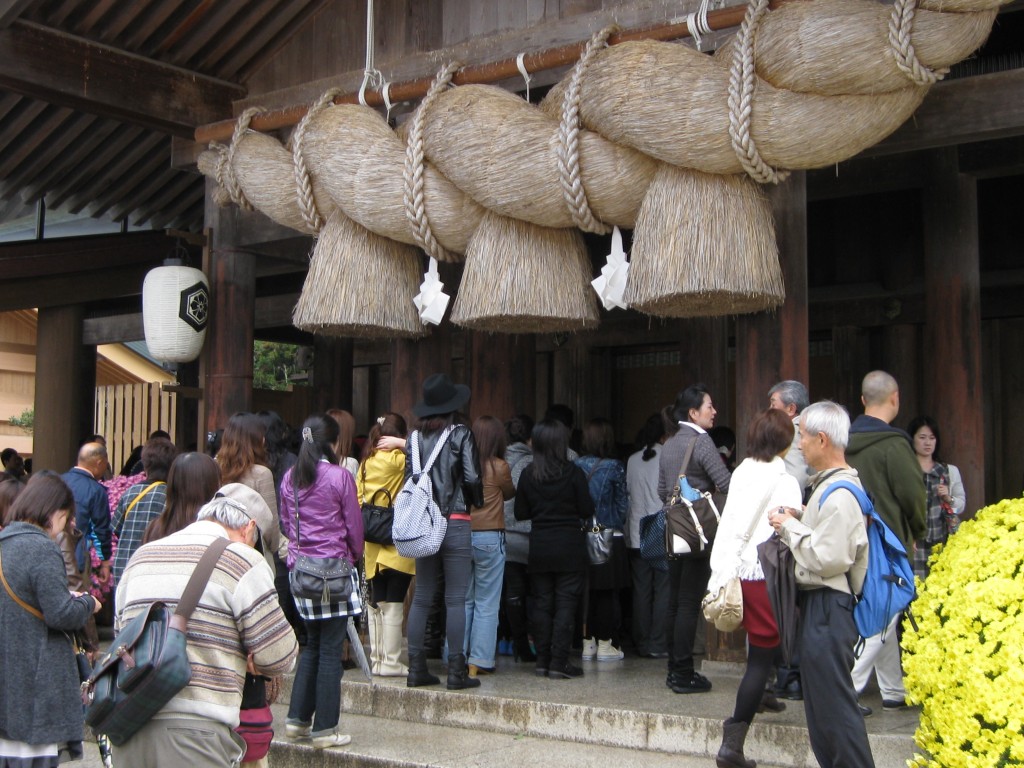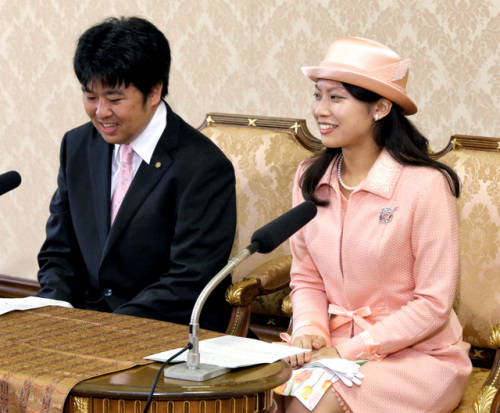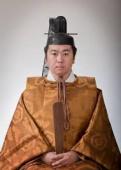
Izumo Shrine's reputation as the most famous 'enmusubi' (love connection) spot in Japan is likely to be cemented by news that the son of its chief priest met his imperial fiancée at the shrine
In Japanese mythology – ancient history perhaps – Izumo was a leading kingdom which was absorbed into the Yamato state after several emissaries (armies) were dispatched. Izumo agreed to cede worldly power in return for spiritual autonomy, and a huge shrine was erected for worship of the clan founder, Okuninushi.
A millennium and a half later the ties between the ancient kingdoms are being renewed. In a stunning affirmation of tradition, an imperial princess of the Yamato lineage has become engaged to the son of the chief priest of Izumo. The latter holds a hereditary position allegedly stretching back to a time when a descendant of the Sun Goddess took charge at the Izumo shrine (see below).
It speaks to the hold that the Yamato dynasty still has over the nation, to the power of tradition in Japan, and to the vital role of the heredity principle in the country’s affairs, even now in a supposedly ‘democratic age’.
****************************************************
Princess Noriko to wed son of Izumo-Taisha chief priest
KYODO MAY 27, 2014

Press interview to announce the wedding of Princess Noriko and Senge Kunimaro (Wikicommons)
Princess Noriko, second daughter of Princess Hisako and the late Prince Takamado, has become engaged to the eldest son of the chief priest of Izumo-Taisha, the grand shrine in Izumo, Shimane Prefecture, the Imperial Household Agency said on Tuesday.
Princess Noriko, 25, and Kunimaro Senge, 40, will wed this autumn, according to the agency.
It will be the first marriage involving an Imperial family member since Princess Sayako, now Sayako Kuroda, married an official of the Tokyo Metropolitan Government in 2005.
The Senge family has been in charge of shrine rituals at Izumo-Taisha for generations, and had been friendly with Prince Takamado and Princess Hisako before the prince passed away in 2002.
Princess Noriko first met her fiance in April 2007, while she was on a visit to the shrine with her mother.
A graduate of Gakushuin University, she has two sisters; her elder sister Princess Tsuguko and younger sister Princess Ayako.
Kunimaro Senge served as priest at shrines in Tokyo and Kyoto after graduating from Kokugakuin University, and has assisted his father, Takamasa Senge, 71, since March 2005. He has two younger brothers.
Prince Takamado was the third son of Prince Mikasa, the youngest brother of Emperor Hirohito, posthumously known as Emperor Showa.
Princess Hisako said of the engagement, “I hope Noriko will raise a loving and happy family and will adapt to a new life.”
“”””””””””””””””””””””””””””””””””””””””
http://the-japan-news.com/news/article/0001311030

Princess Noriko (copyright Yomiuri)
The engagement between Princess Noriko and Kunimaro Senge, 40, will become formal after “Nosai no gi,” a traditional rite of betrothal, scheduled for July. The wedding will be held in Izumo Taisha around October, according to the agency.
Senge was born on Sept. 2, 1973, the eldest son of Takamasa Senge, the 71-year-old chief priest of Izumo Taisha, and his wife Ayako, 64.
The Senge family has been in charge of rituals at the shrine for generations. Senge studied Shinto at Kokugakuin University and has served as a priest at multiple shrines, including Iwashimizu Hachimangu shrine in Kyoto, after graduating from university.
He is currently holds the position of “negi” senior priest at Izumo Taisha. He takes photographs as a hobby.
“””””””””””””””””””””””””””””””””””””””””
http://blogs.wsj.com/japanrealtime/2014/05/27/wedding-bells-to-ring-for-japanese-princess/
As required by Imperial House Law, Princess Noriko will exit the Imperial House upon marrying. With only three princes in line to succeed the current Emperor, and the seven princesses possibly marrying outside of the Imperial Family, Princess Noriko’s marriage could reignite the discussion on amending this law to ensure the stable continuation of the Imperial Family.
The administration under the previous Democratic Party of Japan considered amending the law to allow the Emperor’s daughters and granddaughters to remain in the Imperial House after marriage. But the discussion has stalled under current administration of Prime Minister Shinzo Abe.
“””””””””””””””””””””””””””””””””””””””””””””
Kunimaro Senge’s Facebook page: https://www.facebook.com/people/Kunimaro-Senge/100005746385569

Senge Kunimaro (Yomiuri)
Administrator’s Family (Senge family) Wikipedia…
The descendants of Amenohohi-no-mikoto, the second son of Amaterasu-oh-mi-kami, the sun goddess whose first son is the ancestor of the imperial family, have been, in the name of Izumo Kokuso, or governor of Izumo, taking over rituals because when Izumo-taisha was founded Amenohohi-no-mikoto rendered service to Okuninushi-no-kami.
The family’s conflict around 1340 made them separated into two linage, Senge(千家) and Kitajima. After the separation those two families took the position of Izumo Kokuso by turns until late 19th century.
Shintoism was reconstructed as modernized Japan’s national religion in late 19th century . In 1871 Izumo-taisha was designated as an Imperial-associated shrine and the government sent a new administrator so Izumo kokuso families were no more the administrators of Izumo-taisha. Senge and Kitajima established their own religious corporations respectively, Izumo-taisha-kyo by Senge, and Izumo-kyo by Kitajima.
Under the allied occupation after World War Two, Shintoism was separated from the government control and Izumo-taisha was reformed into a private shrine, then Senge and its Izumo-taisha-kyo took back the position of the administrator of Izumo-taisha.
Takatoshi Senge, the 83rd-generation head of Senge linage, was chosen to be the chief priest of Izumo-taisha in 1947. He died in February 2002 at the age of 89. Now the position of the administrator of Izumo-taisha is succeeded by Senge linage.
*************************************************
Asked at the May 27 news conference how she felt about having to leave the imperial family, Princess Noriko said she is not in a position to comment on the issue.
“I feel a certain sadness in leaving the imperial family and anxieties about a new life in Izumo, but it seems not different from what many women feel when they get married,” she said.
(http://ajw.asahi.com/article/behind_news/social_affairs/AJ201405280042 by Yasuhiko Shima and Ayako Nakada.)
***************************************************
Bird-watching acts as cupid by The Yomiuri Shimbun
Bird-watching served as cupid for Princess Noriko and Izumo Taisha shrine priest Kunimaro Senge, whose engagement was decided informally Tuesday.
They came to know each other through bird-watching, a common hobby of their families. The two families have been on familiar terms since before Princess Noriko’s father, Prince Takamado, died suddenly in November 2002.
Princess Noriko, 25, and Senge, 40, have fostered their love through the close friendly relationship of the two families.
Princess Hisako and Princess Noriko, her second daughter, entered the Imperial Palace before 10 a.m. Tuesday and reported the informal engagement with Senge to the Emperor and Empress. Their marriage plans have rapidly accelerated since the turn of the year, said sources close to their families. They first met when Princess Noriko and her mother visited Izumo Taisha in Izumo, Shimane Prefecture, in April 2007 after Princess Noriko, then 18, entered Gakushuin University in Tokyo.

Tying the knot in a big way

I saw it on NHK news, a big thing
Senge lineage is the second most ancient dynasty in Japan (the first one is of course the Imperial Family).
Their believers consider the High Priest as an existence above the clouds, but strangely, it doesn’t disturb american, chinese and korean critics (nobody else really care, in fact when people from other countries know somehow about this business, it’s just like the Kamikaze and Shinpu-tai affair -___-). It is okay for a Gûji but not for the Emperor ? I would like to understand the logic of those statement, but I know it is impossible, because those people brandishing the “Ningen Sengen” without understanding it’s meaning… those people are of the same kind as those who said Lavoisier was wrong, and continue to say it, without nobody caring or noticing. And when Lavoisier will be (once again) proven right, it will be butthurt for all the world, not just for some fiat money fanatics.